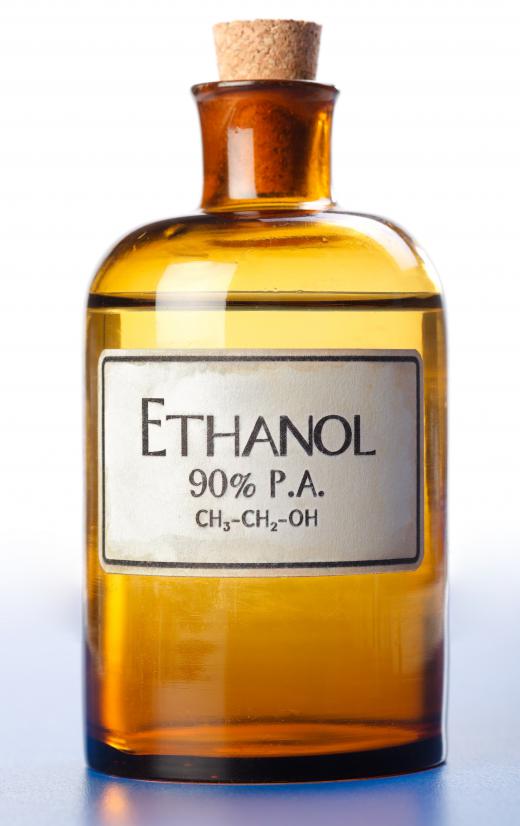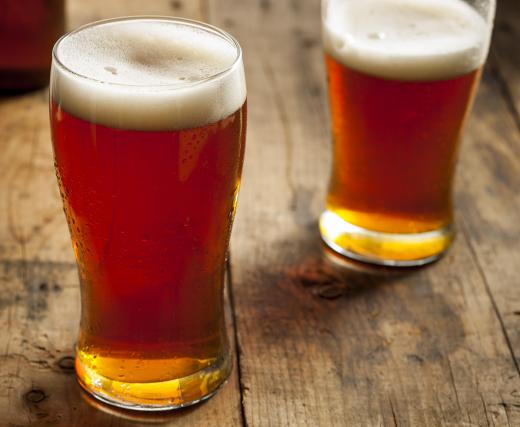An ethanol still is a device used to separate ethyl alcohol from water and other substances. This is done through a process called distillation. Distillation heats a mixture to a specific temperature. At this point, either one substance in the mixture will boil and become a gas or both substances will turn into a gas. In a simple still, this gas is then drawn away from the mixture and cooled. If both substances are in the gas, the substance with the highest boiling point is usually cooled and separated first while the other substance continues further through the still. A mixture may have to be distilled multiple times in order to get a high purity level.
Ethanol is an alcohol. Each molecule of ethanol has two carbon atoms, six hydrogen atoms, and one oxygen atom. Ethanol has a lower boiling point than water, meaning it becomes a gas at a lower temperature. It is primarily created by yeast through a process called fermentation. It has many uses, but the two it is best known for are for fuel and for human consumption.

When used as a fuel, the alcohol can either be used in a pure form or mixed with other chemicals. These fuel forms include traditional North American gasoline that is mixed with a small percentage of ethanol, E85 fuel that is roughly 85 percent ethyl alcohol, and pure ethanol that can be used in specialized vehicles. When consumed by humans, ethanol is almost always mixed with other substances. It is the primary alcohol in beer, wine, hard liquor, and other alcoholic beverages.

Ethanol is often not in its desired form when it is first produced. This is because ethyl alcohol is created through fermentation. The fermentation process results in a mixture of alcohol, water, and other substances. This mixture has a very low percentage of ethyl alcohol in it. In order to get a higher level, the mixture is put through various processes. The process that results in the highest percentage of ethanol is called distillation.

Ethanol distillation is done using an ethanol still. A still used specifically for ethanol is heated and cooled so that the ethanol separates from the water and other substances it is mixed with. There are many different types ofthese ethanol stills, but they all work on the same basic principle of boiling and cooling the mixture.
The simplest modern ethanol still is a pot still. Pot stills heat a batch of alcohol-containing liquid in a large pot. The vapors released from the heated liquid contain a higher percentage of alcohol than the mixture because alcohol has a higher boiling point. These vapors travel up a large tube called a column. As the vapor cools in the column, water liquefies out of the vapor and falls back into the pot. The remaining vapor contains an even higher percentage of alcohol, and is then cooled and collected in another vessel.
Another type of ethanol still is one that uses fractional distillation. In fractional distillation, the column contains either plates or packing material. As the alcohol-containing steam rises through the column, it continuously condenses as it makes contact with the cooler plates and packing material. Vapors from below cause the liquid further up the column to once more become a gas, but the gas contains a higher percentage of alcohol than before. Once the gas makes it out of the column, it contains a very high percentage of alcohol.
Still builders can be very clever, and have been known to use other types of stills and hybrid systems to get higher concentrations of alcohol. Vacuum stills, steam stills, and even evaporators have all been used to extract alcohol. Some of these types of stills are used so that flavors are retained in the resulting alcohol-mix. At other times, these stills are used to increase the speed of distillation, separate out more dangerous chemicals, or simply because the still builder wants to try a more interesting design.
